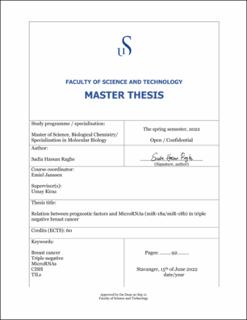| dc.description.abstract | Breast cancer is the most common type of malignancy found in women. It is a very heterogenous
disease and treatments vary accordingly. Triple negative breast cancer (TNBC) is the most
aggressive subtype of breast cancer and is often found in younger women or women of African
descent. It is recognized by its lack of expression of estrogen receptor (ER), progesterone
receptor (PR) or the human epidermal growth receptor 2 (HER2). Due to the lack of these
receptors, treatment options are very limited, and chemotherapy is often the only choice
available for patients. However, several other ways to treat TNBC is under investigation and
strong emphasis are placed to discover prognostic and predictive markers that can predict or aid
in the treatment of this cancer.
MicroRNAs are short non-coding RNA molecules that form around 19-22 nucleotides in length
and are tasked to up/downregulate gene expression post-transcriptionally by either binding to the
messenger RNA (mRNA) targets or by cleaving them. Functionally, they maintain balance in
normal cells by regulating cellular growth, proliferation, differentiation and apoptosis. In breast
cancer, the expression of some of these microRNAs have been recognized to possess either
oncogenic or tumor-suppressing properties. MicroRNA 18a and 18b especially, which are part of
the miR-17-92 cluster, have been considered to be oncogenic, and their overexpression in tumor
cells have shown to enhance cell proliferation, trigger angiogenesis, block differentiation, and
promote metastasis and evasion of an apoptotic response. Due to their significant contribution to
cancer growth, microRNAs in general are very valuable biomarkers to target as potential
prognostic markers or novel therapeutic agents for TNBC.
The aim of this study is to count the mitotic activity index (MAI), TILs and miR-18a/b in the
tumor microenvironment of TNBC to investigate whether any correlation exists between them,
and the other factors and characteristics related to TNBC and its prognosis. There are two main
objectives to this thesis. Firstly, to statistically analyze MAI, TILs and other characteristics of
TNBC in the Norwegian cohort (n= 271) at the University Hospital of Stavanger to find good
prognostic markers for TNBC, and secondly, to measure the expression of microRNAs 18a and
18b using CISH. Statistical analyses will be done to determine whether either or both of these
microRNAs are significant enough to be considered as prognostic markers for TNBC.
From the larger cohort of TNBC cases of those that were alive and well, those with local
reoccurrence and those dead of the disease with distant metastasis at the end of their follow-up
status (n=195), the results showed that the lymph node status, when negative (p=0.000,
HR=0.300, 95% CI=0.181–0.497) was the most significant factor for a good prognosis. The age
at the time of diagnosis (p=0.001, HR=2.053, 95% CI=1.329–3.171) and the fibrotic focus
(p=0.017, HR=1.670, 95% CI=1.092–2.55) were also significant factors that showed a trend
towards greater survival and good prognosis when combined with the negative lymph node
status. From the CISH group (n=42), miR-18a showed a significant correlation with the
Nottingham grade (p=0.066) and tumor type (p=0.003). On the other hand, miR-18b showed
correlation with MAI (p=0.056), TILs (p=0.028), lymph infiltration (p=0.001) and tumor type
(p=0.004). No difference was observed between patients with or without distant metastasis in the
CISH cohort when all cases were observed together. However, when only lymph node negative
cases were isolated from the rest and selected, a trend was observed in patients who didn’t
experience distant metastasis when they had higher numbers of positive miR-18b cells. In
conclusion, the findings in this thesis suggest that the lymph node status is a good predictive
prognostic marker for TNBC along with fibrotic focus. From the microRNAs, miR-18b seem to
be a good prognostic marker in lymph node negative TNBC patients and should be further
studied. The sample sizes used for this study were small, and these results should be interpreted
with caution and further validation is recommended. | |
